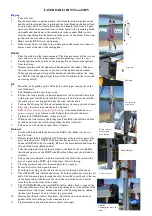
this potential error source by providing two
terminals of constant current and an additional
two terminals for high impedance voltage
measurement. The result is a fast, accurate
resistance measurement of the test resistance,
independent of the resistance of the current
carrying leads.
Figure D-1 illustrates the 4-wire principle
eliminates lead, wire and contact resistances as
potential error sources. The internal constant
current source inherently overcomes all series
resistance (within compliance voltage limits)
and delivers a precise constant current.
Separate DC to DC isolation circuitry provides
independent circuit voltage supplies for both
polarities of the constant current source
circuit
. The internal high-impedance Digital
Voltmeter (DVM) senses the voltage drop
across the test resistance (i.e. squib or
detonator). There is negligible contact and lead
resistance error created by the voltage
measurement because the high input impedance
of the DVM limits current flow in the voltage
(V
hi
and V
low
) leads.
D-6.
Connections
Connections are made to the front panel
terminals using a 4-wire configuration as
described in section D-5. Use only AMPTEC
test leads supplied with the 620A 4R Failsafe
Ohmmeter. When using AMPTEC test leads,
plug the test leads vertically into the 620A-4R
banana jacks (they can’t plug in horizontally) .
of the 620A 4R. AMPTEC 620A 4R leads have
the 4 wire current high, current low as well as
the voltage sense high and voltage sense low
routed to the end of the leads. The last tip or jaw
part of the alligator leads becomes a 2 wire
connection typically adding only 1 to 2
milliohms worth of in-series resistance to the
measurement. One banana plug (red) for current
and voltage high, and another banana plug
(black) for current and voltage low.
For 620A 4R leads other than those terminated
with banana plugs, RG-58 Shielded Coax
Cabling is used. Maintaining the four wire
Kelvin measurement, the current is in the
largest conductor and the voltage input is
shielded.
In addition, custom probes and test lead sets are
optionally available for customized wiring
connections , kelvin clips, cables terminated
with spade lugs, and special banana jacks.
All AMPTEC ohmmeters use a high impedance
voltmeter as part of the resistance measurement
process. This voltmeter is a highly accurate and
stable 4½ digit analog-to-digital converter (A to
D). The unit’s high impedance DVM (digital
voltmeter) must receive a voltage input signal or
drop in order to display the proper value. When
the DVM is not receiving a definite input
signal, the output reading from the Analog to
Digital Convertor can appear random and
wandering. The display may indicate a
randomly wandering number or it may indicate
an overrange (flashing) condition. This
unpredictable display (No input to the DVM)
condition may make it seem to appear that the
instrument is experiencing some sort of
malfunction. It is not a malfunction, in fact, just
a characteristic of the high impedance voltmeter
circuit and
should not be mistaken for a fault in
the instrument
- As this condition is simply a
state of an “open circuit” or “nothing
connected” to the DVM circuitry. A flashing
display (on and off usually all zeros) indicates
an over-range condition whenever the terminals
are open, or the resistance under test is a higher
value than the selected 620 series Igniter Tester
resistance range. By using a 4-wire Kelvin type
lead set or by shorting the V and I terminals
HI
HI
together and V
and I
terminals together
low
low
the instrument is in the 2 wire resistance mode.
All wiring including harness wires from the two
wire test connection out - are in series with the
test squib resistance and become part of the
actual two wire measurement (another potential
source of measurement error if not compensated
for) . Many Ordnance test procedures have the
620 series Igniter Tester user short their wiring
harnesses at the very end (by the squib) and
record the resistance value or offset. Then when
the 620 series Igniter Tester leads, including the
in-series harness wiring resistance, is connected
to the test squib, the squib test resistance can be
calculated (via subtraction of the 2 wire harness
offset).
Summary of Contents for 620A 4R
Page 28: ......
















































